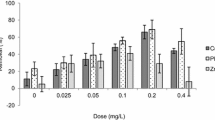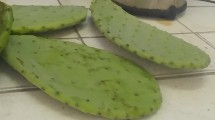Abstract
Coagulation–flocculation processes play an important role in the treatment of water using inorganic and synthetic materials. Presently, cactus Opuntia ficus indica is explored as a cheap, abundant and eco-friendly bioflocculant of Pb(II) ions from aqueous solutions. The cactus powder was characterized by Fourier transform infrared spectrometer (FTIR), and the coagulation–flocculation process was optimized for pH, initial concentration of Pb(II) ions, particle size, dosage, ionic strength, contact time and temperature before its application to Mukuvisi River water. FTIR confirmed the involvement of –C–O–C–, –OH, –C=O, –N–H and –C–H groups of the polysaccharides, carboxylic acids and amino acids in the removal of Pb(II) ions. The variation of percentage removal and zeta potential with pH and flocculant dosage suggested the involvement of adsorption–charge neutralization and adsorption–bridging mechanisms in the coagulation–flocculation process. The process was optimum at pH 5, natural ionic strength, dosage of 8 mg/L, corresponding to zero zeta potential, with particle size <75 µm, at 35 °C for a floc settling time of 180 min. The coagulation–flocculation process was spontaneous and endothermic with a positive change in entropy of the system. Total heavy metal removal of 100 % (Pb), 85.74 % (Zn), 84.16 % (Cd) and 93.02 % (Cu) were achieved, under optimum conditions, when Opuntia ficus indica powder was used to remove metals from water sampled from Mukuvisi River, Harare, Zimbabwe. The cactus Opuntia ficus indica powder was found to be an efficient, eco-friendly flocculant that can effectively remediate Pb(II) ions from wastewaters.







Similar content being viewed by others
References
Abia AA, Harsfall M, Didi O (2003) The use of chemically modified and unmodified cassava waste for the removal of Cd, Cu and Zn ions from aqueous solution. Bioresour Technol 90(3):345–348. doi:10.1016/S0960-8524(03)00145-7
Akan JC, Abdulrahman FI, Dimari GA, Ogugbuaja VO (2008) Physico-chemical determination of pollutants in waste water and vegetable samples along Jakara waste water Channelin Kano State, Nigeria. Eur J Sci Res 23(1):122–133
Armenante PM (2014) Coagulation and flocculation. cpe.njit.edu/dlnotes/che685/cls07-1.pdf. Accessed 22 Nov 2014
Awwad AM, Salem NM (2014) Kinetics and thermodynamics of Cd(II) biosorption onto loquat (Eriobotrya japonica) leaves. J Saudi Chem Soc 18(5):486–493. doi:10.1016/j.jscs.2011.10.007
Aygun A, Yilmaz T (2010) Improvement of coagulation–flocculation process for treatment of detergent wastewaters using coagulant aids. Int J Chem Environ Eng 1(2):98–101
Barakat MA (2011) New trends in removing heavy metals from industrial wastewater: review article. Arab J Chem 4:361–377
Bouatay F, Mhenni F (2014) Use of the cactus cladodes mucilage (Opuntia Ficus Indica) as an eco-friendly flocculant: process development and optimization using statistical analysis. Int J Environ Res 8(4):1295–1308
Bratby J (1980) Coagulation and flocculation with an emphasis on water and wastewater treatment. www.ircwash.org/sites/default/files/253-80CO-1277.pdf. Accessed 09 Mar 2015
Bustillos LGT, Carpinteyro-Urban S, Departamento CO (2013) Production and characterization of Opuntia ficus indica mucilage and its use as coagulant–flocculant aid for industrial wastewaters. Int J Biotechnol Res 1(3):038–045
Buthelezi SP, Olaniran AO, Pillay B (2012) Textile dye removal from wastewater effluents using bio-flocculants produced by indigenous bacterial isolates. Molecules 17:14260–14274. doi:10.3390/molecules171214260
Carpinteyro-Urban S, Torres LG (2013) Use of response surface methodology in the optimization of coagulation–flocculation of wastewaters employing biopolymers. Int J Environ Res 7(3):717–726
Chukwudi BC, Uche R (2008) Flocculation of kaolinite clay using natural polymer. Pac J Sci Technol 9(2):495–501
de Souza MTF, Ambrosio E, de Almeida CA, Souza Freitas TKF, Santos LB, de Cinque Almeida V, Garcia JC (2014) The use of a natural coagulant (Opuntia ficus-indica) in the removal for organic materials of textile effluents. Environ Monit Assess 186:5261–5271. doi:10.1007/s10661-014-3775-9
Duan J, Gregory J (2003) Coagulation by hydrolyzing metal salts. Adv Colloid Interface Sci 100–102:475–502
El-Sayed GO, Dessouki HA, Ibrahiem SS (2011) Removal of Zn (II), Cd (II) and Mn(II) from aqueous solution by adsorption on maize stalks. Malays J Anal Sci 15(1):8–21
Fedala N, Lounici H, Drouichec N, Mameria N, Drouiche M (2015) Physical parameters affecting coagulation of turbid water with Opuntia ficus-indica cactus. Ecol Eng 77:33–36. doi:10.1016/j.ecoleng.2015.01.007
Ganji MT, Khosravi M, Rakhshaee R (2005) Biosorption of Pb, Cd, Cu and Zn from the wastewater by treated Azolla filiculoides with H2O2/MgCl2. Int J Environ Sci Tech 1(4):265–271
Hameed MSA (2006) Continuous removal and recovery of lead by alginate beads, free and alginate-immobilized Chlorella vulgaris. Afr J Biotechnol 5(19):1819–1823
Jadhav MV, Mahajan YS (2014) Assessment of feasibility of natural coagulants in turbidity removal and modeling of coagulation process. Desalin Water Treat 52:5812–5821. doi:10.1080/19443994.2013.816875
Karthika K, Thirunavukkanasu A, Ramesh S (2010) Biosorption of copper from aqueous solution using Tridax procumbens. Rec Res Sci Tech 2(3):86–91
Kurama H, Karaguzel C (2013) The effect of zeta potential on the sedimentation behaviour of natural stone processing effluent. Physicochem Probl Miner Process 49(2):575–586. doi:10.5277/ppmp130218
Lee DW (2014) Spotlight: an overview of coagulation–flocculation technology. Water conditioning and purification. http://www.wcponline.com/pdf/April_2014_Wilson.pdf. Accessed 14 Feb 2015
Li Z, Li N, Zhang H, Liu D (2009) Studies and application processes on flocculant in water treatment in China. EJGE 14:134–138. http://www.ejge.com/2009/Ppr09107/Ppr09107.pdf Accessed 21 Nov 2014
Mahmood T, Salman AM, Syed TH (2010) Biosorption and recovery of heavy metals from aqueous solutions by water hyacinth ash. BioResources 52(2):1244–1256
Mane PC, Bhosle AB, Jangam CM, Mukate SV (2011) Heavy metal removal from aqueous solution by Opuntia: a natural polyelectrolyte. J Nat Prod Plant Resour 1(1):75–80
Masere TP, Munodawafa A, Chitata T (2012) Assessment of human impact on water quality along Manyame River. Int J Dev Sustain 1 (3): 754–765. isdsnet.com/ijds-v1n3-10.pdf.Accessed 15 Nov 2014
Mataka LM, Henry EMT, Sajidu SM (2006) Lead remediation of contaminated water using Moringa stenopetala and Moringa oleifera seed powder. Int J Environ Sci Tech 3(2):131–139
Mataka LM, Sajidu SMI, Mwatseteza JF (2010) Cadmium sorption by Moringa stenopetala and Moringa oleifera seed powders: batch, time, temperature, pH and adsorption isotherm studies. Int J Water Res Environ Eng 2(3):55–67
Miller S, Fugate E, Craver VO, Smith JA, Zimmerman JB (2008) Toward understanding the efficacy and mechanism of Opuntia spp. as a natural coagulant for potential application in water treatment. Environ Sci Technol 42:4274–4279
Mishra A, Malvika B (2005) Flocculation behavior of model textile waste water treated with a food grade polysaccharide. J Hazard Mater 118(1–3):213–217. doi:10.1016/j.jhazmat.2004.11.003
Mohammad I, Aziz Ghazi ZA, Sohail M, Muhammad A, Khan ZU (2014) Investigation of the activity of sawdust as biosorbent towards Cr(VI) removal from waste water: kinetic and thermodynamic studies. Int Res J Environ Sci 3(4):5–12
Moss N, Dymond B (2015) Flocculation: theory and application. www.siltstop.com/pdf/flocculation-theory_application.pdf. Accessed 09 Mar 2015
Mounir B, Abdeljalil Z, Abdellah A (2014) Comparison of the efficacy of two Bio-flocculants in water treatment. Int J Sci Eng Technol 3(6):734–737
Ndabigengesere A, Narasiah KS, Talbot BG (1995) Active agents and mechanism of coagulation of turbid waters using Moringa oleifera. Water Res 29(2):703–710
Okoye AI, Ejikeme PM, Onukwuli OD (2010) Lead removal from wastewater using fluted pumpkin seed shell activated carbon: adsorption modeling and kinetics. Int J Environ Sci Tech 7(4):793–800
Rattanakawin C (2005) Aggregate size distributions in sweep flocculation. Songklanakarin J Sci Technol 27(5):1095–1101
Renault F, Sancey B, Badot PM, Crini G (2009) Review article: Chitosan for coagulation/flocculation processes: an eco-friendly approach. Eur Polymer J 45:1337–1348. doi:10.1016/j.eurpolymj.2008.12.027
Sarı A, Tuzen M (2009) Kinetic and equilibrium studies of biosorption of Pb(II) and Cd(II) from aqueous solution by macro fungus (Amanita rubescens) biomass. J Hazard Mater 164:1004–1011. doi:10.1016/j.jhazmat.2008.09.002
Sharma BR, Dhuldhaya NC, Merchant UC (2006) Flocculants an eco-friendly approach. J Polym Environ 14:195–202. doi:10.1007/s10924-006-0011-x
Shilpa BS, Akanksha Kavita, Girish P (2012) Evaluation of cactus and hyacinth bean peels as natural coagulants. Int J Chem Environ Eng 3(3):187–191
Singha B, Naiya TK, Bhattacharya AK, Das SK (2011) Cr (VI) ions removal from aqueous solutions using natural adsorbents-FTIR studies. J Environ Prot 2:729–735. doi:10.4236/jep.2011.26084
Taher A, Farooqui M, Farooqui M (2012) The comparative study in kinetic, thermodynamic and ionic strength: on the adsorption of copper (II) by different low cost materials. J Chem Biol Phys Sci 2(2):661–667
Tripathy T, De BR (2006) Flocculation: a new way to treat the waste water. J Phys Sci 10:93–127
Varsha P, Jay P (2012) Mucilage extract of Cocinia indica fruit as coagulant–flocculant for turbidity water treatment. Asian J Plant Sci Res 2(4):442–445
Vijayaragharan G, Sivakumar T, Vimal K (2011) Application of plant based coagulant for waste water treatment. Int J Adv Eng Res Stud 1(1):89–93
Vishali S, Karthikeyan R (2014) Cactus opuntia (ficus-indica): an eco-friendly alternative coagulant in the treatment of paint effluent. Desalin Water Treat. doi:10.1080/19443994.2014.945487
Acknowledgments
We wish to thank the Department of Chemical Technology technical staff of (removed for the purpose of blinding the manuscript) for their technical support.
Author information
Authors and Affiliations
Corresponding author
Rights and permissions
About this article
Cite this article
Nharingo, T., Zivurawa, M.T. & Guyo, U. Exploring the use of cactus Opuntia ficus indica in the biocoagulation–flocculation of Pb(II) ions from wastewaters. Int. J. Environ. Sci. Technol. 12, 3791–3802 (2015). https://doi.org/10.1007/s13762-015-0815-0
Received:
Revised:
Accepted:
Published:
Issue Date:
DOI: https://doi.org/10.1007/s13762-015-0815-0




